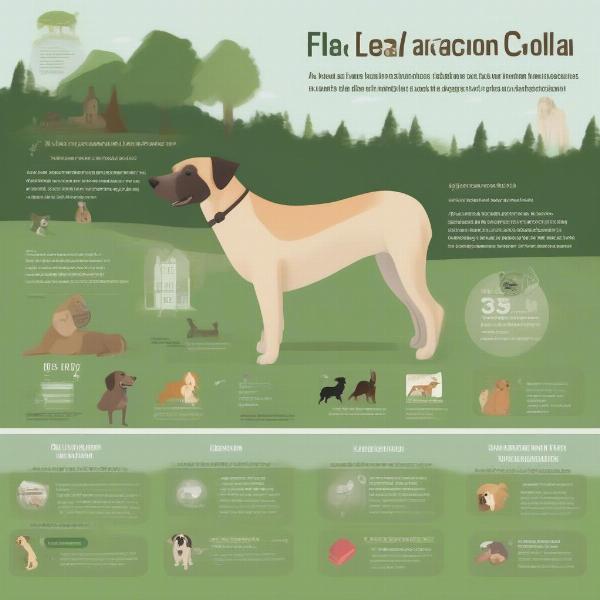Flea and tick collars offer a convenient and long-lasting way to protect your dog from these pesky parasites. Choosing the right flea and tick collar for dogs can be overwhelming with so many options available. This guide will help you understand the different types of collars, their benefits and drawbacks, and how to choose the best one for your furry friend.
Types of Flea and Tick Collars for Dogs
Flea and tick collars utilize different active ingredients and mechanisms to repel or kill parasites. The most common types include:
- Seresto Collars: These collars release low doses of imidacloprid and flumethrin over several months, providing long-lasting protection against fleas and ticks.
- Scalibor Collars: Containing deltamethrin, these collars work by repelling and killing ticks, and also offer some protection against mosquitoes and sandflies.
- Kiltix Collars: These collars contain propoxur and flumethrin, offering protection against both fleas and ticks for a shorter duration compared to Seresto.
- Natural Flea and Tick Collars: These collars typically use essential oils or plant-based ingredients like citronella, geranium, or peppermint oil to repel fleas and ticks.
How to Choose the Right Flea and Tick Collar
Selecting the appropriate flea and tick collar depends on several factors, including your dog’s age, breed, health, lifestyle, and the prevalence of parasites in your area.
Consider Your Dog’s Age and Health
Puppies and senior dogs may have more sensitive skin and require collars specifically designed for their age group. If your dog has any pre-existing health conditions, consult your veterinarian before using any flea and tick collar.
Assess Your Dog’s Lifestyle
If your dog spends a lot of time outdoors, especially in wooded areas or tall grass, a collar with stronger and longer-lasting protection might be necessary. For dogs that primarily stay indoors, a natural collar might be sufficient.
Evaluate the Parasite Prevalence in Your Area
Research the types of fleas and ticks common in your region. Some collars are more effective against certain species than others.
 Choosing the Right Flea and Tick Collar
Choosing the Right Flea and Tick Collar
Applying and Maintaining the Flea and Tick Collar
Most flea and tick collars are easy to apply. Ensure the collar fits snugly but allows for two fingers to fit between the collar and your dog’s neck. Trim any excess length after fastening the collar. Monitor your dog for any signs of skin irritation and consult your veterinarian if any issues arise.
How Long Do Flea and Tick Collars Last?
The duration of effectiveness varies depending on the brand and type of collar. Some collars provide protection for up to eight months, while others need to be replaced more frequently. Always check the manufacturer’s instructions.
Are Flea and Tick Collars Safe for Dogs?
When used correctly, most flea and tick collars are safe for dogs. However, some dogs may experience mild skin irritation or other side effects. Always follow the manufacturer’s instructions and consult your veterinarian if you have any concerns.
Conclusion
Flea and tick collars provide a convenient way to protect your dog from these parasites. By carefully considering your dog’s needs and the available options, you can choose the best flea and tick collar for dogs to ensure their health and comfort. Always consult your veterinarian if you have any questions or concerns about using flea and tick collars.
FAQ
- How often should I replace my dog’s flea and tick collar? This depends on the specific collar. Check the manufacturer’s instructions for recommended replacement frequency.
- Can I use a flea and tick collar on a puppy? Yes, but make sure to choose a collar specifically designed for puppies.
- What should I do if my dog experiences skin irritation from the collar? Remove the collar immediately and consult your veterinarian.
- Are natural flea and tick collars as effective as chemical collars? Natural collars may be less effective than chemical collars, particularly in areas with high parasite prevalence.
- Can I use a flea and tick collar in conjunction with other flea and tick prevention methods? Consult your veterinarian before combining different prevention methods.
- Can my dog swim while wearing a flea and tick collar? Check the manufacturer’s instructions, as some collars may lose effectiveness after swimming.
- What are the signs of a flea or tick infestation on my dog? Excessive scratching, biting, hair loss, and small dark specks (flea dirt) on the skin are common signs.
bayer seresto flea and tick collar for dogs stores
best natural flea and tick collar for dogs
herbal flea and tick collars for dogs
natural flea and tick collar for dogs
ILM Dog is a leading international website dedicated to providing expert advice and resources on dog care and breeding. We offer comprehensive information on various aspects of dog ownership, from breed selection and health care to training, nutrition, and grooming. For expert advice or further assistance, contact us at [email protected] or +44 20-3965-8624. Visit ILM Dog for more information on dog care and breeding.